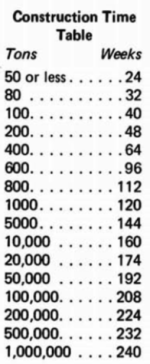By accident I happened upon an old post talking about how one Traveller player calculates ship construction times.
And I opened up High Guard, and The Traveller Book, and started back-calculating.
He suggests some invariant time for controls and life support, then a scale based on tonnage. I think that these estimates would include drive and sensor installation, inspection and shakedown flight. I also think that weapons are installed by the purchaser after delivery.
At any rate, I take High Guard's rule and extend it, since ships as small as 1,000 tons take 30 weeks to complete. That factoid allows me to adjust the rule to fit the ACS divide:
Now for ACS, I want to approximate Book 2 custom-hull data. There's two ways to do this.
Way 1. Break it down and interpolate into the Book 2 table.
Way 2. Normalize the curve and set weeks = (Hull/100) + 10. It's close enough, to the point where the difference just doesn't matter. Note the price skew in the middle tonnages. Nobody really cares. The Burrito Principle dictates that Good Enough is indeed sufficient. The resulting table is:
Missing. Neither solution accommodate differing hull configurations. Again, it probably doesn't matter.
And I opened up High Guard, and The Traveller Book, and started back-calculating.
He suggests some invariant time for controls and life support, then a scale based on tonnage. I think that these estimates would include drive and sensor installation, inspection and shakedown flight. I also think that weapons are installed by the purchaser after delivery.
At any rate, I take High Guard's rule and extend it, since ships as small as 1,000 tons take 30 weeks to complete. That factoid allows me to adjust the rule to fit the ACS divide:
1. Ships 2,500 tons and over require from 24 to 60 months to complete, based on conditions, volume of orders, and the degree of haste desired by the ordering government.
Now for ACS, I want to approximate Book 2 custom-hull data. There's two ways to do this.
Way 1. Break it down and interpolate into the Book 2 table.
| 100 | 200 | 300 | 400 | 500 | 600 | 700 | 800 | 900 | 1000 | 1100 | 1200 | 1300 | 1400 | 1500 | 1600 | 1700 | 1800 | 1900 | 2000 | 2100 | 2200 | 2300 | 2400 |
|---|---|---|---|---|---|---|---|---|---|---|---|---|---|---|---|---|---|---|---|---|---|---|---|
| 10 | 12 | 14 | 16 | 22 | 24 | 26 | 28 | 29 | 30 | 30 | 30 | 30 | 31 | 31 | 31 | 31 | 31 | 31 | 32 | 32 | 32 | 32 | 32 |
Way 2. Normalize the curve and set weeks = (Hull/100) + 10. It's close enough, to the point where the difference just doesn't matter. Note the price skew in the middle tonnages. Nobody really cares. The Burrito Principle dictates that Good Enough is indeed sufficient. The resulting table is:
| 100 | 200 | 300 | 400 | 500 | 600 | 700 | 800 | 900 | 1000 | 1100 | 1200 | 1300 | 1400 | 1500 | 1600 | 1700 | 1800 | 1900 | 2000 | 2100 | 2200 | 2300 | 2400 |
|---|---|---|---|---|---|---|---|---|---|---|---|---|---|---|---|---|---|---|---|---|---|---|---|
| 11 | 12 | 13 | 14 | 15 | 16 | 17 | 18 | 19 | 20 | 21 | 22 | 23 | 24 | 25 | 26 | 27 | 28 | 29 | 30 | 31 | 32 | 33 | 34 |
Missing. Neither solution accommodate differing hull configurations. Again, it probably doesn't matter.

